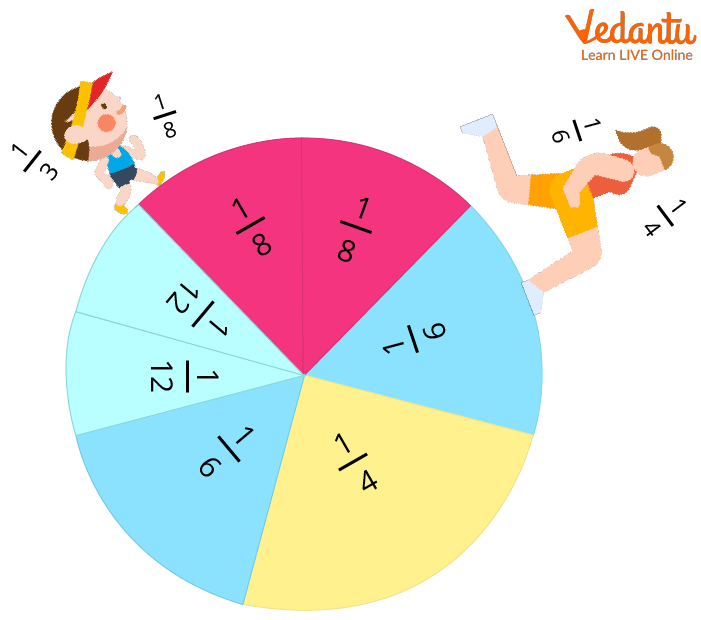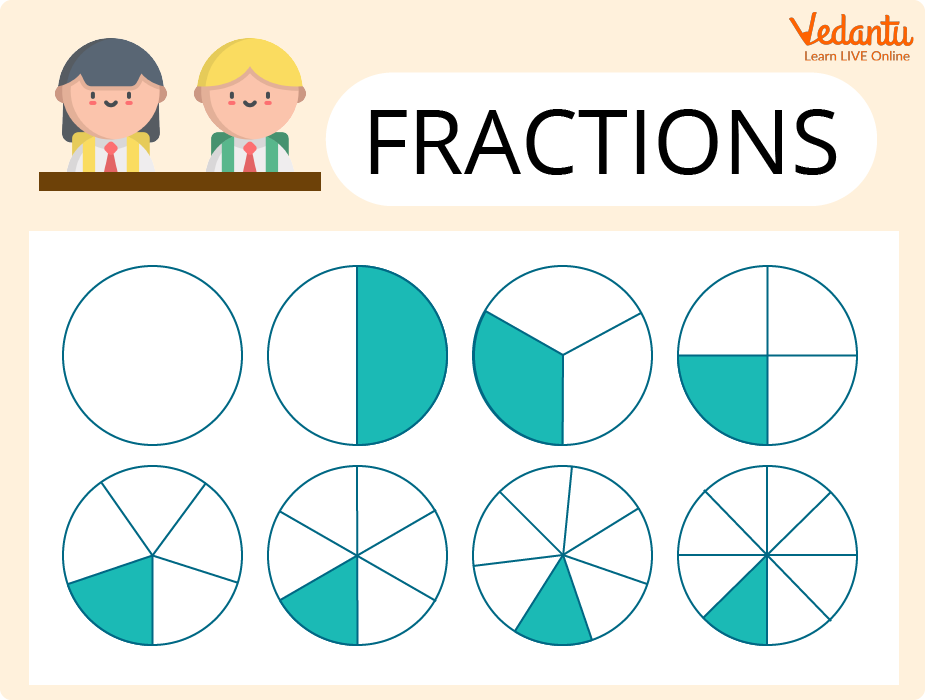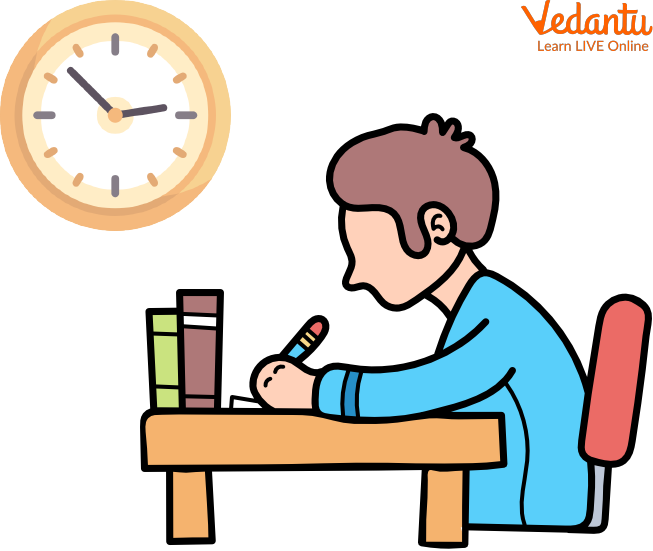




Key Rules and Examples for Adding Fractions
You must know about fractions. Fraction is a part of the whole. In fractions, we have a numerator and denominator; the numerator represents parts, and the denominator represents the whole in the fraction. In this article, you will be learning about the addition of fractions.
In addition of fractions, when the denominators are the same, then the addition of fractions seems easy, but when denominators are different then, how will you add them?

Fractions
Before we get into the matter, we need to know what a fraction is, what a like and unlike fraction is, and how to convert an unlike fraction to a like fraction.
There are numerous ways to make fractions enjoyable for children. As we deal with fractions daily, it's simple to let them enjoyably explore the concept.
Definition of a Fraction

Learning Fractions
Fractions are used to represent smaller portions of a larger whole. The components could make up a single thing or multiple things. In any case, they combine to form what is known as a whole.
Types of Fractions

Adding Fractions
To add fractions successfully, students must first understand the differences between each type of fraction.
Parts of a whole are represented by fractions. In a fraction, the denominator represents the number of equal parts in a whole, and the numerator represents how many parts are being considered.

Circle Divided Into Four Parts
The circle is divided into four parts in the diagram above. As a result, the fraction is $\dfrac{1}{4}$ or a quarter.
Proper, improper, and mixed fractions are the three types of fractions.
Proper Fraction: The numerator is less than the denominator. e.g- $\dfrac{3}{4}$ (three quarters)
Improper Fraction: The numerator is greater than the denominator. e.g- $\dfrac{7}{4}$ (seven quarters)
Mixed Fraction: A whole number and a proper fraction combined. e.g- $1\dfrac{3}{4}$ (one and three quarters).
Furthermore, fraction equations will be divided into two groups:
Like fractions: Fractions with the same denominator. e.g- $\dfrac{1}{4}$ and $\dfrac{3}{4}$
Unlike fractions: Fractions with different denominators. e.g- $\dfrac{1}{4}$ and $\dfrac{3}{8}$
How to Add Two Fractions- Steps for Adding Fractions

Teaching Addition Through Pizza Slices
The Addition of Fractions may appear difficult at first, but with practice, you'll be up and running as quickly as possible.
Here are a few steps on how to add fractions:
Check to see if the denominators of the fractions are the same.
Convert them to equivalent fractions with the same denominator if they don't have the same denominator.
Add the numbers in the numerator once they have the same denominator.
Put the new numerator over the denominator in your answer.
When you converted the fractions to the same common denominator, the denominator may have changed.
Tips for Adding Fractions


Learning Fractions in Part-whole
Before you add fractions, make sure the denominators are the same.
The value of a fraction remains the same when the top and bottom are multiplied by the same number.
Converting fractions to common denominators should be practised. Adding fractions is the most difficult part.
After you've finished the addition of fractions, you might need to simplify your answer.
If you're adding mixed numbers, make sure to convert them to improper numbers first.
Addition of Fraction Examples
Addition of Fraction With Same and Different Numerator

Let’s Learn
Following are examples of the addition of fractions-
Example 1: ($\dfrac{5}{8}+\dfrac{2}{8}$)=?
Step 1: Denominators are the same.
Step 2: Take the numerators 5 and 2, respectively and add them.
= $\dfrac{5+2}{8}$
Step 3: Give the final answer.
= $\dfrac{7}{8}$
In the above example, we learned how to add two fractions.
Example 2: $\dfrac{3}{8}+\dfrac{5}{12}$=?
Step 1: Denominators are different. So, take the Least Common Multiple (LCM).
24 is a common multiple of 8 and 12.
Step 2: Make the denominators equal by multiplying $\dfrac{3}{3}$ with $\dfrac{3}{8}$ and multiplying $\dfrac{2}{2}$ with $\dfrac{5}{12}$.
$\Rightarrow \dfrac{3}{8}=\dfrac{3}{8}\times \dfrac{3}{3}$
$=\dfrac{9}{24}$
Also, $\Rightarrow \dfrac{5}{12}=\dfrac{5}{12}\times \dfrac{2}{2}$
$=\dfrac{10}{24}$
Step 3: Take the numerators and add.
$\Rightarrow \dfrac{3}{8}+\dfrac{5}{12}$
$=\dfrac{9}{24}+\dfrac{10}{24}$
$=\dfrac{9+10}{24}$
Step 4: Answer = $\dfrac{19}{24}$
In the above example, we learned the addition of fractions with different denominators.
Types of Fractions
Let’s Practice

Solving Problems
Learning from the addition of fractions examples, let us solve the following problems on our own. Following are the fraction addition sums-
1. Add: $\dfrac{7}{10}+\dfrac{2}{10}$ (Ans: ($\dfrac{9}{10}$))
2. Add: $\dfrac{5}{10}+\dfrac{2}{10}$ (Ans: ($\dfrac{7}{10}$))
Summary
To summarise, students must understand that fractions are more than just shading and colouring. A fraction is a part of the whole. A common fraction is a numeral which represents a rational number. Fractions are numbers that lie between two consecutive whole numbers. Use fractions in everyday conversations as a parent, relate fractions to real-life situations and provide examples from everyday activities such as cooking, baking, time, and measurement.
FAQs on How to Add Fractions: Step-by-Step Guide
1. What is the fundamental rule for adding fractions?
The fundamental rule for adding fractions is that they must have a common denominator. The denominator represents the total number of equal parts a whole is divided into. You can only add the numerators (the parts you have) once the size of these parts (the denominator) is the same for all fractions in the sum.
2. How do you add fractions with the same denominator step-by-step?
Adding fractions with the same (or like) denominators is straightforward. Follow these steps:
- Keep the denominator the same.
- Add the numerators together.
- Simplify the resulting fraction if possible.
3. What is the process for adding fractions with different denominators?
To add fractions with different (or unlike) denominators, you must first make them the same. The process is:
- Find the Least Common Multiple (LCM) of the denominators. This will be your new common denominator.
- Convert each fraction into an equivalent fraction with this new denominator.
- Once the denominators are the same, add the new numerators.
- Simplify the final fraction to its lowest terms.
4. How do you add a whole number and a fraction?
To add a whole number and a fraction, you can convert the whole number into a fraction. Any whole number can be written as a fraction by placing it over a denominator of 1. For example, the number 5 is the same as 5/1. After this, you follow the standard rules for adding fractions with different denominators by finding the LCM. For example, 5 + 2/3 becomes 5/1 + 2/3.
5. What is the correct method for adding mixed fractions?
The most reliable method for adding mixed fractions is to first convert them into improper fractions. To do this, multiply the whole number by the denominator and add the numerator. This result becomes the new numerator over the original denominator. Once all mixed fractions are converted to improper fractions, you can add them using the standard rules for like or unlike denominators, as per the CBSE 2025-26 syllabus.
6. Why can't we just add the denominators when adding two fractions?
We cannot add denominators because the denominator defines the size of each part of the whole. Think of it like adding 1 apple and 2 oranges; you can't say you have 3 "apple-oranges". Similarly, adding 1/2 and 1/3 means adding one piece from a whole split into two, and another piece from a whole split into three. The pieces are different sizes. To add them correctly, you must first cut them into smaller, equally-sized pieces by finding a common denominator, like converting them to 3/6 and 2/6, before you can count the total number of these new, uniform pieces.
7. What is the real-world importance of finding a common denominator?
Finding a common denominator has many real-world applications. For instance, if a recipe calls for 1/2 cup of flour and you need to add another 1/3 cup, you need a common unit to measure accurately. Similarly, in construction or carpentry, a professional might need to combine two pieces of wood with lengths like 3/4 inch and 5/8 inch. To find the total length, they must use a common denominator (8) to add 6/8 and 5/8 together, ensuring a precise fit.
8. How are equivalent fractions essential for the process of adding fractions?
Equivalent fractions are the core concept that makes adding fractions with different denominators possible. When we find a common denominator, we are not changing the value of the original fractions. Instead, we are converting them into their equivalent forms that happen to share the same denominator. For example, 1/2 is equivalent to 3/6. This allows us to add 'like with like' without altering the original quantities, ensuring the sum is accurate and meaningful.























